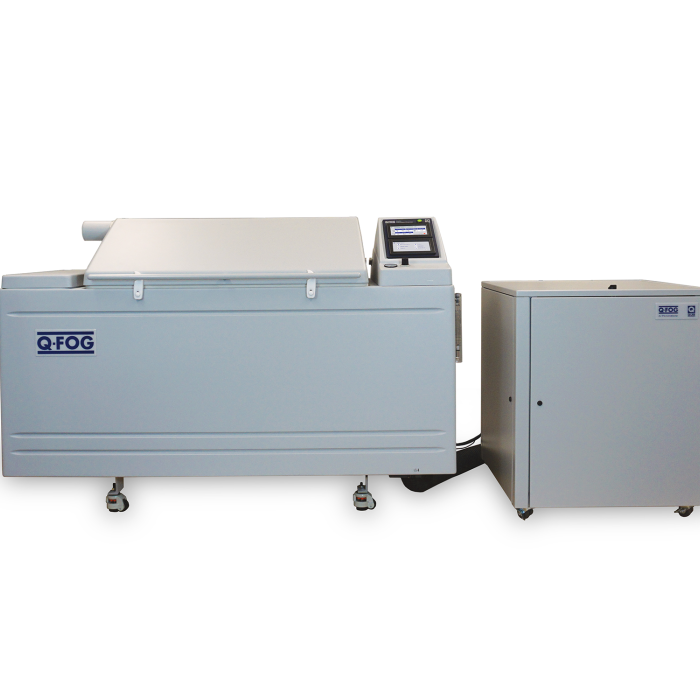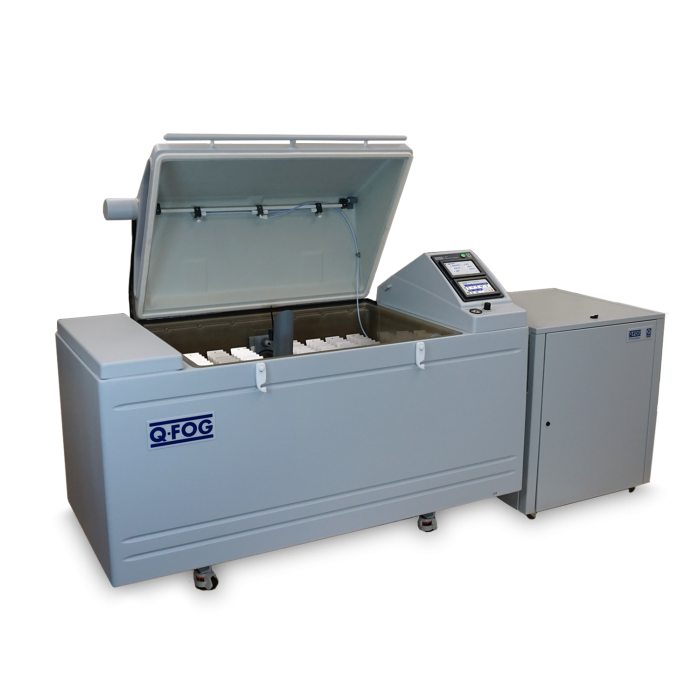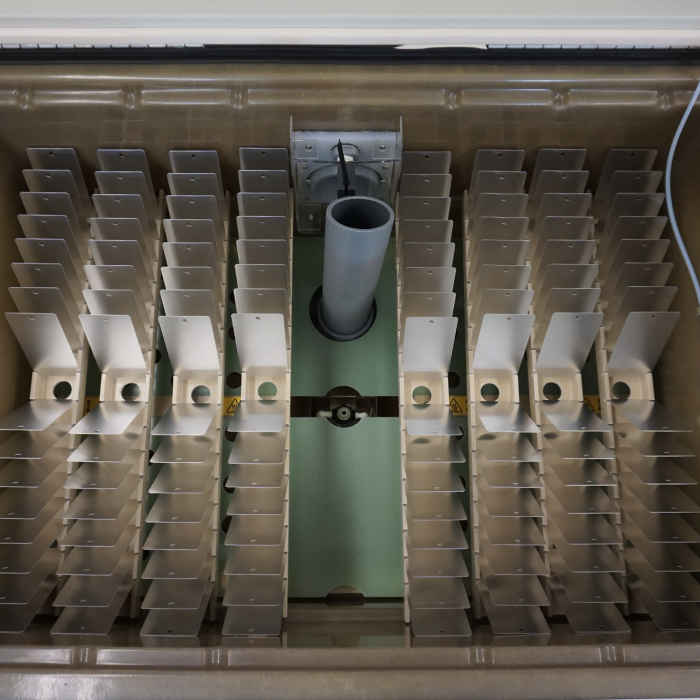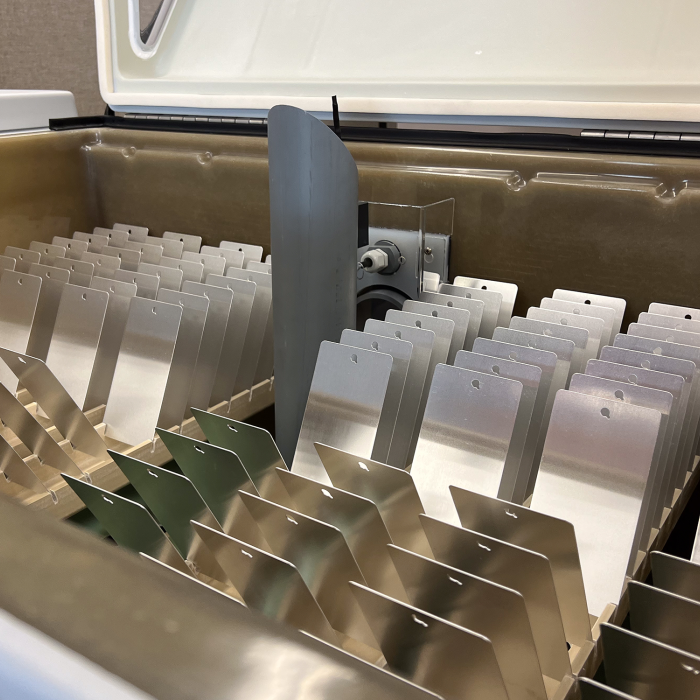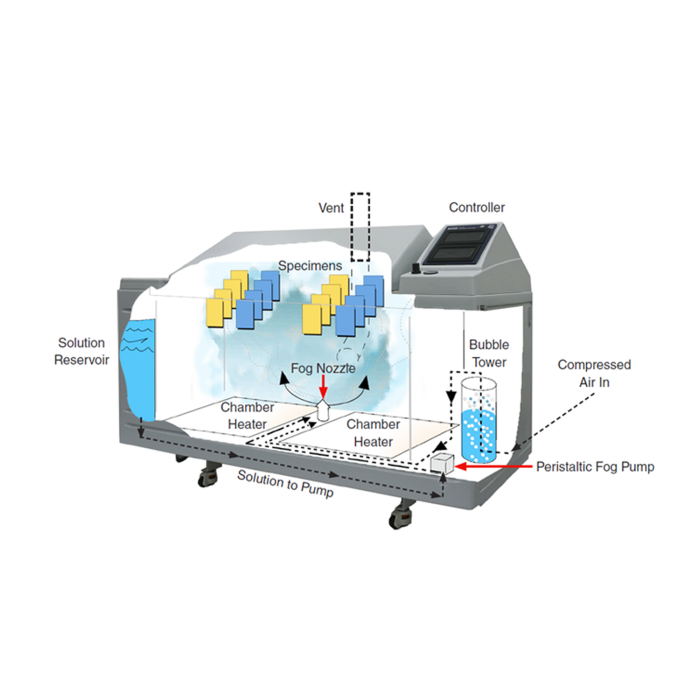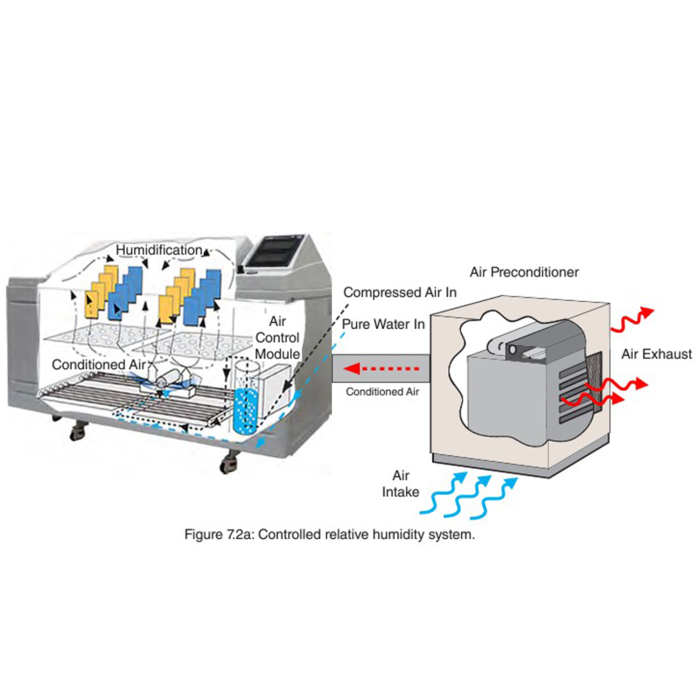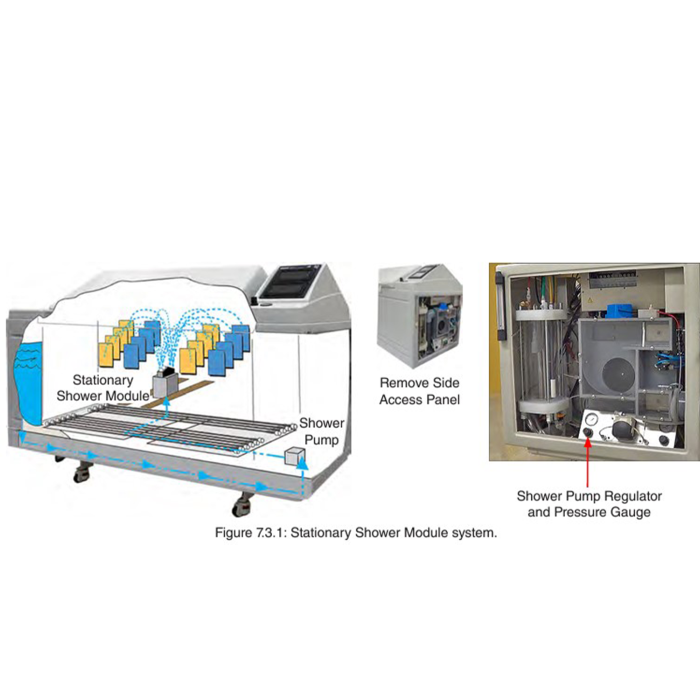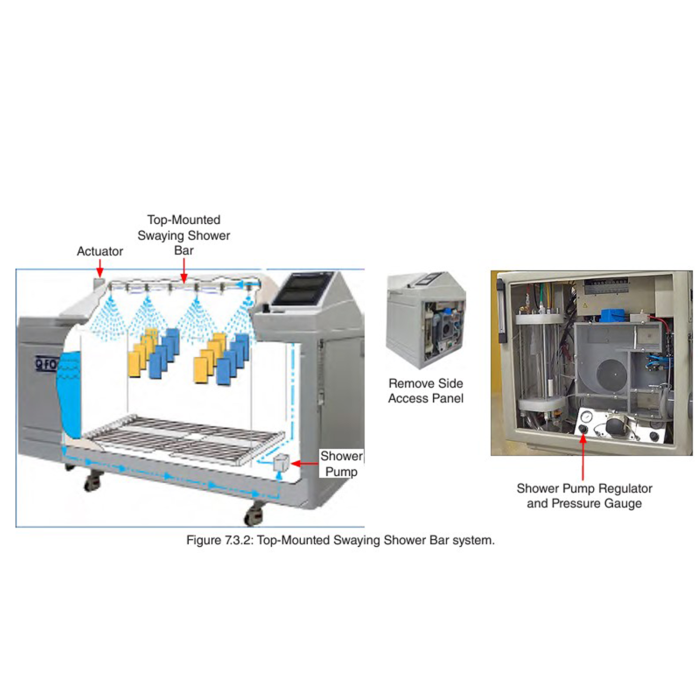Q-FOG CRH
Controlled Relative Humidity Testers
Cyclic corrosion testing provides the best possible laboratory simulation of natural atmospheric corrosion. Research indicates that test results are similar to those obtained outdoors in resulting structure, morphology, and relative corrosion rates.
Q-FOG CRH cyclic corrosion chambers can perform traditional salt spray, Prohesion, and nearly all cyclic automotive tests. They feature fully-adjustable relative humidity and precise control over ramp times. An optional shower function is also available in center-mounted stationary or overhead (top-mounted) swaying configuration. Rapid Ramp Heater capability enables performance of automotive corrosion tests that have very fast transition times.
Q-FOG chambers are available in two sizes to fulfill a wide range of testing requirements. Q-FOG cyclic corrosion testers are the simplest, most reliable, and easiest-to-use corrosion testers available.
Cyclic Corrosion Testing
The Q-FOG model CRH represents a true breakthrough in the price-to-performance ratio of corrosion testers with relative humidity control. It can perform most major automotive corrosion test standards, such as GMW 14872, SAE J2334, and many more from Ford, ISO, GB/T, VW, Volvo, Chrysler, Renault, JASO, and others.
The tester has all the features and advantages required in cyclic corrosion testers, as well as full variable relative humidity control through the use of an innovative air preconditioner. Additionally, the CRH model includes a Shower function that can be used interchangeably with traditional salt fog. With the Shower Function, spray droplets are much bigger, flow rates are much higher, and salt application times are much shorter than the traditional atomized mist in the Salt Fog function. The Shower function is available in a configuration mounted in the center (stationary), or as a top-mounted (swaying) shower bar to meet the mandatory language in some key corrosion tests. The CRH tester features an advanced cleaning feature for spray nozzles that prevents the clogging frequently found in competitive chambers. See the Q-FOG Brochure for complete information.
Within one Q-FOG CRH chamber, it is possible to cycle through a series of the most significant corrosion environments. Even extremely complex test cycles can easily be programmed with the Q-FOG controller. Visit our standards page for a detailed list of test methods met by the Q-FOG CRH chamber.
Configurations
- Q-FOG CRH600-HSC (or 1100-HSC): conventional salt fog and Prohesion tests, humidity control, stationary shower module, approximately 600 liter (or 1100 liter) chamber volume
- Q-FOG CRH600-HSCR (or 1100-HSCR): conventional salt fog and Prohesion tests, humidity control, stationary shower module, fast temperature and relative humidity transitions, approximately 600 liter (or 1100 liter) chamber volume
- Q-FOG CRH600-HTC (or 1100-HTC): conventional salt fog and Prohesion tests, humidity control, top-mounted swaying shower bar, approximately 600 liter (or 1100 liter) chamber volume
- Q-FOG CRH600-HTCR (or 1100-HTCR): conventional salt fog and Prohesion tests, humidity control, top-mounted swaying shower bar, fast temperature and relative humidity transitions, approximately 600 liter (or 1100 liter) chamber volume
See Q-FOG Specifications for comparative information, or see the Features Tab.
Relative Humidity (RH) and Shower Functions
The Q-FOG model CRH can ramp to and maintain a defined RH value and temperature through the use of an air preconditioner, an air control module, and special atomizing humidification nozzles. Deionized (DI) water is required for proper operation.
The Shower function in the Q-FOG CRH is used for some automotive test specifications. A user-adjustable volume of solution is uniformly sprayed onto specimens through specially-positioned spray nozzles. The Shower function offers the following advantages:
- Nozzles are mounted to either a stationary shower module in the chamber center or a top-mounted swaying shower bar. Either shower configuration can be easily removed when using the Fog function
- Spray droplets are much bigger, flow rates are much higher, and shower times are much shorter than the atomized solution mist in the Fog function
- Shower on/off times can be programmed to allow for excellent control of corrosion rates
Precise Control of Fog Dispersion
The Q-FOG cyclic corrosion chamber has superior fog dispersion compared to conventional systems, which cannot vary volume and distance independently. A variable-speed peristaltic pump controls the amount of corrosive solution delivered to the spray atomizer, while the air pressure regulator controls the distance of the “throw.” Note that purified water is required for proper operation of Q-FOG corrosion testers. See The Importance of Water Purity for more information.
Solution Reservoir
Space utilization is maximized and maintenance is minimized with the Q-FOG tester's internal solution reservoir. The 120 liter reservoir has enough capacity for running most tests for 7 days or more. The reservoir has an integral salt filter and a built-in alarm to alert the operator when the solution is low. The integrated reservoir can optionally be connected to an external tank.
Rapid Ramp Heater for Fast Temperature and RH Cycling
Q-FOG testers can change temperatures exceptionally fast because of their unique internal chamber heater and their high volume cooling/dry-off blower. An additional air heater allows very low humidity dry-off exposures. Conventional chambers with water jackets cannot cycle rapidly because of the thermal mass of the water, nor can they achieve low humidity conditions.
If fast heating or dry-off conditions are required, as prescribed in test standards ISO 11997 and automotive CCT-type tests like JASO M609, the CRH model can be configured with Rapid Ramp Heaters. This Rapid Ramp Heater system enables quick temperature and relative humidity transitions in a fully-loaded chamber in order to meet the requirements of these demanding automotive test standards.
Calibration
The Q-FOG CRH tester’s chamber temperature and RH sensors should be calibrated by the user every six months to ensure accurate and consistent results.
Calibrating the temperature and RH sensors takes only a few minutes. It requires simple tools, a calibrated reference thermometer, and an insulated container.
Easy Programming and Specimen Mounting
Test conditions, time, and temperature are controlled by a built-in microprocessor. A remarkably simple user interface featuring dual, full-color touchscreens allows for easy user programming and operation in 17 user-selectable languages (English, French, Spanish, Italian, German, Chinese, Korean, Japanese, Czech, Dutch, Polish, Portuguese, Russian, Swedish, Thai, Turkish, and Vietnamese). The operator can quickly create new cycles, or run any of the pre-programmed cycles. The Q-FOG controller includes complete self-diagnostics, including warning messages, routine service reminders, and safety shutdown.
An external USB port on every Q-FOG tester allows users to perform software upgrades quickly to address key performance issues. For quality systems that require documented proof of test conditions, this USB port can also be used to download tester performance history with Q-Lab's VIRTUAL STRIPCHART application. Data from the USB export can be emailed directly to Q-Lab's technical support desk for expert troubleshooting and diagnostics.
Q-FOG CRH units come equipped with a viewing window in the side of the lid and an internal light to allow easy monitoring of the test conditions. Q-FOG CRH testers have a low belt line and an easy-opening lid for easy specimen mounting.
Affordable
Q-FOG cyclic corrosion testers offer state-of-the-art corrosion testing technology, reliability, ease of operation, and easy maintenance – all at a remarkably affordable price.
Specimen Holders
Standard test panel racks are available to accommodate flat specimens, such as Q-PANEL standard substrates. Racks can support up to 113 kg (250 lb) each, and are slotted at 15° from vertical (6° also available). Specimens are tilted towards the chamber rear for “S” models and towards the center for “T” models. The 600 liter "S" model can accommodate up to 170 specimens (160 for "T" models), 75 × 150 mm (3 × 6 in) in size. The 1100 liter model can hold up to 252 specimens (240 for "T" models).
Oddly-shaped parts, like large, three-dimensional specimens, can be mounted on special 20 mm hanging rods.
For extremely large or heavy three-dimensional objects (such as metal wheel rims, engine parts, etc.), a rack-level or diffusion-level grate kit may be used. The Q-FOG tester’s sturdy construction can support a well-distributed total load of up to 544 kg (1200 lb), ensuring compatibility with even the heaviest of automotive and other components.
See our Q-FOG Specimen Mounting bulletin for more information on specimen racks, rods, and grates.
Chamber Access Port
A test chamber access port is available for connecting specimens in the test chamber to external devices. Cables, wires, or hoses can be inserted through a hole in the front of the tester. This option is often used to keep electrical devices powered on during testing.
Other Accessories
Q-Lab offers a fog collection kit for the Q-FOG tester, which consists of a set of six graduated cylinders, o-rings, and collection funnels. Fog collection is required by some tests. Additionally, a kit to perform these collections external to the chamber is available, which avoids having to interrupt testing for fog measurement.
A convenient salt kit is available, containing a pre-measured and certified quantity of NaCl (530 g), which allows for compatibility with ASTM B117. Just add the recommended amount of water to obtain a 5% solution.
Also available are a preventive maintenance parts kit and a nozzle cleaning kit. These give users everything they need for the first full year of operation.
Mass-loss coupons
Corrosion (or "mass loss") coupons ensure repeatability and reproducibility when performing laboratory corrosion testing. They help a user independently monitor the test conditions in the chamber, by measuring the mass loss of the coupons as the test progresses. CX corrosion coupons are designed to meet the stringent requirements specified in modern corrosion test methods, such as GMW14872, GM9540P, SAE J2334, SAE J2721, ASTM B117, ISO 9227, and VDA-233-102.
All Q-PANEL CX-series corrosion coupons include a Certificate of Analysis, and come pre-cleaned and ready to use right out of the package. This allows the user to simply measure the panels and place them in the tester, saving time and effort. And best of all, CX corrosion coupons are often half the price of competitors’ coupons. Q-Lab mass loss coupons are offered in three varieties:
- CXB-12-K 1 × 2 in (25 × 51 mm) - meets requirements of GMW14872, 9540P, SAE J2334, J2721
- CXC-35-K 3 × 5 in (76 × 127 mm) - meets requirements of ASTM B117
- CXD-2.76-5.90-K 2.76 × 5.90 in (70 × 150 mm) meets requirements of ISO 9227, VDA-233-102, GB/T 10125
Visit our Corrosion Coupons page or download the Corrosion Coupons Specification Bulletin for more information.
Looking for additional information on the Q-FOG CRH? Browse our extensive document library for technical articles, technical bulletins, and more. Click here to view translated documents.
More Q-FOG Resources At Your Fingertips
Document Library
Browse Q-Lab’s extensive library of corrosion testing literature and technical content.
Education
Check out blogs, case studies, articles, and webinars to build your knowledge of corrosion testing.
Standards
Review setup and performance information on key international and OEM test standards from ASTM, ISO, SAE, JIS, GB, and more.
